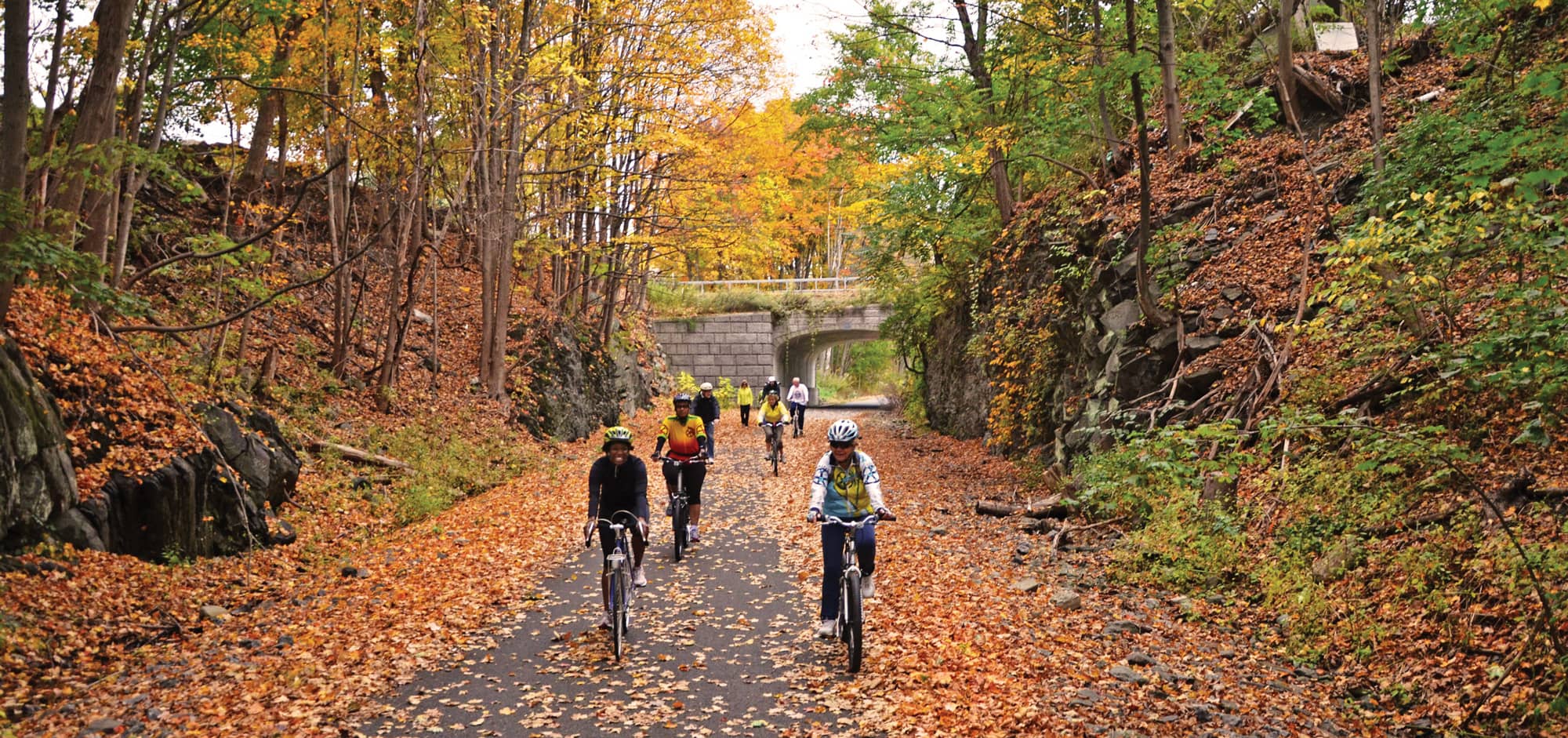Creating a Copenhagen on the Hudson

After nearly a century of building roads primarily for motorists, it’s high time we consider them as public spaces for bicyclists as well.
Copenhagen has done just that. Over the last decade, the city has invested $115 million in bicycling infrastructure — on-street bike lanes, dedicated biking boulevards, even bikes-only bridges. The return has been astounding: Half of daily commutes in Denmark’s capital now take place via bicycle, alleviating traffic congestion, reducing greenhouse gas emissions, and improving public health.
What’s to stop us from following Copenhagen’s lead in the Hudson Valley? In my opinion, nothing. I believe we can make bicycling the dominant mode of getting around the region for work and play. In addition to being a climate solution, it would provide safe transportation for people who lack cars or access to public transit.
Rail trails at the ready
We’re already on the right track. While many people ride rail trails for casual recreation, the ever-expanding network of rail trails in the valley, as well as the Empire State Trail, provide off-road commuting for bikers between dozens of communities. Projects like the Kingston Greenline and the future Dutchess Urban Trail, which will pass through the city and town of Poughkeepsie, afford off-road options for bike commuting and running errands. Walkway Over the Hudson and the shared bike-pedestrian path on the new Gov. Mario M. Cuomo Bridge encourage cross-river commuters to leave their cars at home and avoid the tolls and headaches of being stuck in traffic.
Public transit all aboard
Increasingly, public transportation in the valley supports a bike revolution. All buses in Westchester, Dutchess, and Ulster counties sport bike racks. This can make a big difference in keeping cars off the road, especially in a place like Westchester, where more than 65% of residents live within walking distance of a bus route. This summer, Metro-North also became more bike-friendly: Cyclists no longer must secure permits before boarding trains with their bicycles.
Doing our part
In 2019 the League of American Bicyclists designated Scenic Hudson a bronze-level “Bicycle Friendly Business” based on steps we’ve taken to encourage staff to pedal to work and initiatives to enhance the region’s bike-ability:
- Partnering to create the Hudson River Brickyard Trail: Crossing 520 acres we protected in Ulster County, it extends the potential for local residents to bike to work, shops, and restaurants in downtown Kingston.
- Spearheading efforts to fill in a missing link in the 51-mile Westchester RiverWalk: Closing this gap underneath the Cuomo Bridge, and simultaneously linking the trail to the Metro-North stations in Tarrytown and Sleepy Hollow and the shared-use path over the bridge, will vastly expand opportunities for commuting.
- Partnering with Dutchess County on plans for the Urban Trail: Spanning a former railbed acquired by the county with funding from Scenic Hudson, it will provide safe access to shops, jobs, and schools for residents of Poughkeepsie’s Northside neighborhood.
Next steps for communities
What can valley communities do to make commuting by bicycle more viable? Here are some ideas:
- Make neighborhoods — especially those that have been historically disenfranchised or redlined — more bike-friendly by building safer sidewalks and installing crosswalks, stoplights, and lighting for night-time cycling.
- Redesign roads — make them narrower, with fewer lanes — to reduce drivers’ temptation to speed.
- Ramp up collaboration to build critical infrastructure — safer connections from trails to neighborhoods, sheltered places to store bikes, more dedicated bike lanes in downtowns and on major thoroughfares.
- Ensure that the planning and design of trails and bike routes are safe and accessible to all.
- Increase bike-sharing opportunities in downtowns, especially at Metro-North stations and other key public transit stops.
Next steps we can do together
- Start a campaign in your community to drum up support for new bike trails and safer streets for cycling. This relatively easy action can be the impetus for achieving a cycling transformation. In 2006, respondents to a poll in Seville, Spain, overwhelmingly expressed a need to make the city more bike-friendly. Within 18 months, 40-plus miles of new bike lanes were introduced and the number of trips taken via pedal-power increased 11-fold.
- Encourage your friends and colleagues to hop on their bikes. Having more cyclists on the road is a proven motivator for increasing local investment in infrastructure to accommodate them.
- Of paramount importance, support opportunities to educate bicyclists, pedestrians, and motorists about safe ways to share streets. After several recent cycling fatalities, Ulster County Executive Pat Ryan just urged the county to ramp up bicycle and pedestrian safety efforts. More municipalities should follow his lead. Cycling in the valley won’t really take off until people feel safe doing it.
- Encourage your employer, school, or community to participate in the league of American Bicyclists’ Bicycle Friendly America program.
Today, Copenhagen boasts more than 250 miles of dedicated bike lanes, with an additional 600 miles of paths in surrounding suburbs. A critical mass of residents has adopted cycling as their primary mode of transportation (steep taxes on gasoline and cars support this surge), fueling increased investment in additional bike infrastructure. Bike lanes remain open in winter because the city prioritizes their maintenance, de-icing them before snows falls and clearing them first when it does.
The Hudson Valley has a long way to go to reach this stage, but the worsening climate crisis and the need to embrace social justice are compelling reasons to follow Copenhagen’s lead.
Stay safe and stay strong,


